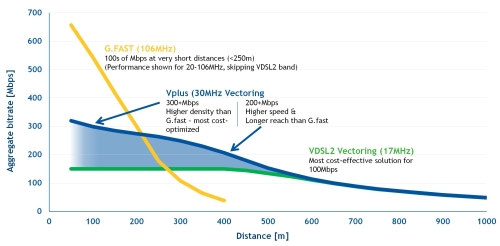The Copper Conundrum for Fixed Broadband Operators
The copper to fiber evolution
Of course we have to consider availability of the different technologies. VDSL vectoring is available today and commercial G.fast products, based on phase 1 of the standard, will be available in 2015. Phase 2 G.fast product should be with us in a few years, as could XG-FAST if standardization and product commercialization go smoothly.
So we are still left with a variety of migration paths from existing copper broadband services to FTTH, and new technologies continue to be added to the mix. For example, based on strong market demand, Alcatel-Lucent is working on a new technology called ‘Vplus’ that could be a very simple and cost-effective way to double VDSL2 vectoring speeds from existing cabinets. Indeed VDSL2 vectoring, Vplus, G.fast and XG-FAST could all play a part in an operator’s network. Let’s have a look at some scenarios.
Figure 4: Speed vs Distance by Technology

With G.fast deployments where a shorter loop length is required, distribution points need to be deployed very close to the customer, in any FTTX location where the operator has access to the copper cable: curb, building, wall, or the generic Fiber to the Distribution Point (FTTdp). These deployment models share similar characteristics: micro nodes, very short loops, a small number of subscribers (tens or fewer), and very high bit rates. They are basically the fixed networks equivalent of wireless small cells.
Beyond bit rates
There are a number of other advantages with G.fast and XG-FAST that go beyond the headline-grabbing bitrates. Reverse powering for the distribution units; flexible downstream/upstream capacity ratios thanks to the use of time division duplexing; easy customer self-installation. The list goes on.
There are inevitably some challenges as well. For example, the frequency range used by G.fast extends into those used for FM and digital radio, and XG-FAST even extends into some military communications frequencies. G.fast ensures harmony by providing a highly-configurable power spectral density (PSD) mask. Operators can use the PSD mask to notch out frequencies that could potentially harm any of the coexisting services. Also, to allow coexistence with VDSL2, operators can configure a starting frequency that allows them to spectrally separate the two technologies and avoid crosstalk.
Powering of micro nodes will also present challenges. Since operators will be deploying thousands of these nodes close to the customer, reverse powering (where you power the device over the telephone line from the customer’s home) is the most practical approach. However, these nodes will need to draw sufficient power and operate efficiently regardless of how many users connect to them or how much load is placed on them. Additionally, they will need to balance power consumption between the users – it would be unfair to draw more power from one customer than from another.
Although not a new challenge, crosstalk is much greater — more like cross-shouting — with G.fast. Vplus, G.fast and XG-FAST will require new approaches to vectoring to cancel the noise.
So super-fast copper broadband technologies promise a lot of benefits, a few deployment headaches and a somewhat bigger problem with regard to which technology operators should choose.
But choice is a good problem to have.



















